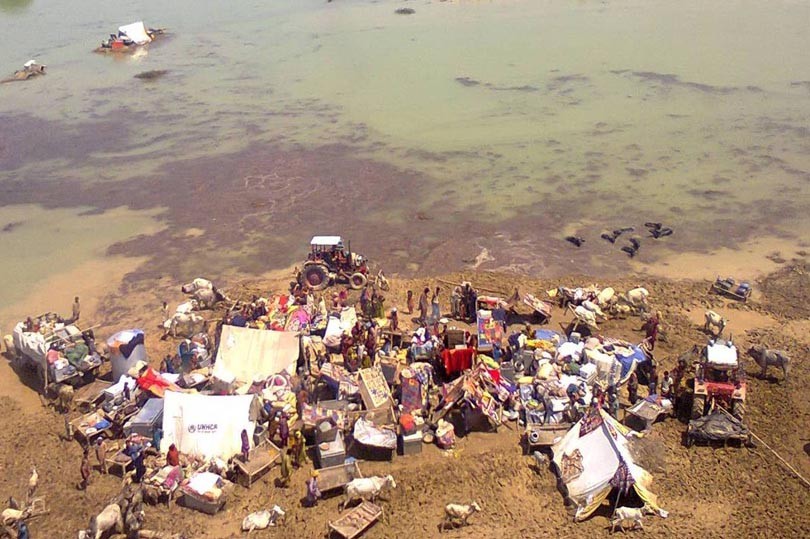It was the third consecutive day that an old lady had taken refuge on the rooftop of her house, in a village of Muzaffargarh, along with her daughter-in-law and three grandchildren. Their house nearly being submerged in flood water and livestock drowned, they had to flee to the rooftop to save their own lives. Having consumed their meager food supplies and drinkable water, they were waiting for a rescue. They had encountered a very furious, unprecedented flood this year!
This seems to be the story of countless households in areas that are prone to get flooded every year. These floods are caused due to several reasons; heavy rains, river overflows, strong winds and tides in coastal areas, dam breakage or ice-melting among others. Floods are classified into different types; however, current discussion will focus on two types, which more commonly occur in Pakistan, i.e. flash floods and riverine floods.
Flash flood is a rapid surge of high water flow, developing within hours of a causative phenomenon, typically occurring in hilly and mountainous areas. They are swift, torrential and devastating, leaving little or no time for evacuation. Much of the destruction is primarily caused by their high torrent and the amount of debris they carry. Heavy rainfall, dam break or ice-melting are their main cause. They are often encountered unexpected, and cause a sudden destruction to houses, roads and bridges while also taking human and animal lives. Flash floods typically last for a short duration.
According to World Resources Institute, on average, inland floods cost an estimated loss of 1% of total GDP per year in Pakistan. Disaster management and rescue operations that are carried out, pose an additional economic burden on the government.
Riverine floods are an overflow of water from natural or artificial stream banks causing inundation of low-lying areas. The nature and impact of riverine flooding varies by their terrain, cause, duration, water flow and depth. In hilly areas they may result into a flash flood due to great velocity of water flow and develop and recede quickly. The inland floods move slowly and last for several weeks. They are the most common perception of the flood phenomenon.
Flood Plains
Flood plains are low-lying fields prone to inundation. They are adjacent to a stream. Flood plains can be narrow and confined channels as in hilly areas or flat and wide as in most inland areas. Narrow flood plains experience deep floods, which quickly develop and recede, while flat flood plains are subject to slow-moving and shallow floods and may remain inundated for several weeks.
Damage Caused by Floods
Floods cause a lot of damages and the intensity of damage depends upon the type of flood, terrain, socio-economic set-up, land-use and population density. Flash floods usually cause a sudden and heavy destruction of structures while slow-moving inland floods fill the houses and other structures for a longer period of time causing total ruining of interior and collapse of weak structures. Flash floods come as a surprise, and are therefore more dangerous. In shallow floods, infections, malnutrition and snakebites account for most casualties and ailments.
In the last few decades, climate change has emerged as an important driving force behind floods in Pakistan, primarily by affecting glacier-melting, and by interfering in summer monsoon patterns.
Flash floods cause immense damage to infrastructure. Transport infrastructures and telecommunication systems are destroyed making it more difficult to extend relief efforts or to provide emergency health care. Water supply and electricity are also usually disrupted.
Floods cause a loss to property, livestock and crop harvest, bringing economic hardships. Many families are left homeless. Country’s GDP is also affected. According to World Resources Institute, on average, inland floods cost an estimated loss of 1% of total GDP per year in Pakistan. Disaster management and rescue operations that are carried out, pose an additional economic burden on the government. Repair or remodeling of the damaged flood protection infrastructures also requires substantial monetary expenditures.
Benefits of Floods
It may come as a surprise to the common reader that apart from their notoriety, floods are an important resource for many communities and freshwater ecosystems. Floods nourish riverine forests which are home to important wildlife species, such as hog dear. Flood waters also provide spawning sites for several fish species. Additionally flood waters recharge groundwater aquifers and add nutrients to soils improving fertility. Floods also feed wetlands which provide an important habitat for many resident and migratory waterfowl species in addition to several aquatic species.
Causes of Floods in Pakistan
Pakistan is subject to periodic flooding of rivers. Glacier-melting, monsoon rains, deforestation in watershed, and siltation are among the principal divers of riverine floods in Pakistan. In the last few decades, climate change has emerged as an important driving force behind floods in Pakistan, primarily by affecting glacier-melting, and by interfering in summer monsoon patterns.
According to a ClimateWire investigation, flash floods that devastated the Northern Areas of Pakistan in 2010 were a result of northwesterly shift of monsoon.
Glacier-Melting: Himalayan glacier-melting has always been a great source of feeding water into the Indus River system, the lifeline of Pakistan. However, with ongoing climate change, the rate of glacier-melting has exacerbated to the levels of concern. On one hand, we are losing a vital resource, and on the other hand, excessive volume of melt-out water contributes to flooding almost every year.
Monsoon Rains: Summer monsoon rains lasting from June to September are the annual raining season of Pakistan. Water carried by monsoon rains feeds rivers and irrigates croplands. Monsoon rains have become erratic as a consequence of climate change, adding to the odds of flooding in rivers already swollen by glacial melt-out water. According to a ClimateWire investigation, flash floods that devastated the Northern Areas of Pakistan in 2010 were a result of northwesterly shift of monsoon. The volume of water and debris sent downstream by these flash floods, coupled with heavy monsoon in Punjab and Sindh, resulted into the worst floods in the history of Pakistan.
At the time of birth, Pakistan had 33% of its land covered by forests which has now shrunk to a mere 3-4%.
Deforestation in Watershed: Apart from natural causes, a major man-made cause is massive deforestation in watersheds. At the time of birth, Pakistan had 33% of its land covered by forests which has now shrunk to a mere 3-4%. Other than local people, a well-organized “timber mafia” under the shadow support of politicians and forest officers involved in malpractice, is the main culprit behind the loss of essential forest cover. Forests or vegetation help protect against floods, both by reducing soil erosion, and by decreasing the amount of runoff water directed towards waterways.
Siltation: Siltation, another main contributor to riverine flooding, refers to the introduction and deposition of sediments (suspended particles) into a water body. These particles settle to the stream bed, and reduce its water-holding capacity, causing them to sprawl outside their banks even on a mild increase in the volume of water. Sediments also fill up water storage reservoirs resulting in a reduction of their water-storage capacity. Tarbela dam has lost 26% of its storage capacity and the rest of the dams have lost an average 23% because of siltation, thereby compounding flood risks. Deforestation in watershed is the direct cause of increased downstream siltation in rivers and filling up of reservoirs. Massive hill torrents from bare soils carry a huge amount of sediments into water bodies.
How it Turn into a Disaster?
While various natural and man-made forces are contributing to floods, the scale of disaster is intensified by many other factors of utmost concern:
Alterations in flood plains: There are vast inland flood plains in the Punjab and Sindh provinces capable of absorbing floods, and dissipating their intensity. However, since waters of Indus River system have receded in recent decades, the problem of encroachments has intensified. There is a network of land grabbers under the supervision of influential politicians and landlords which brings flood plains under illegal occupation. Thousands of people use flood plains for agriculture and/or housing. As a consequence, the scale of disaster raises many folds; often the loudest cries are from these illegal occupants. Moreover, alterations in flood plains change the natural course of flood water causing more destruction. In Sindh province, flood plains have been most severely altered. There are illegal occupants and permanent structures such as roads and bridges as well.
Despite regular flooding, risk monitoring is not up to the mark. Flood warnings are often issued at the 11th hour. The response of people is also surprisingly slow.
Encroachments can also be seen in hilly areas where people have built structures alongside river banks. Bridges have not been constructed according to environmental standards. Resultantly flash floods carry away these structures and bridges, raising the disaster score.
Ecological Degradation: Like other forests, riverine forests of Pakistan have also been chopped down indiscriminately at an approximate rate of 5,683 acres per year. Riverine forests stabilize river banks, prevent soil erosion, and break the flow of flood water. Clearance of riverine forests by locals and timber mafia has exposed important wildlife species to serious conservation threats as well as augmented the rage of flood waters.
Levee Breaches: Levees are embankments made to protect stream overflow. At high flood risk, levees are breached at controlled places to protect important installations and major cities etc. However, sometimes levee breaching is done at an inappropriate place to save the property or croplands of some influential people. Levee breaching diverts an enormous volume of water to an area often with very little or no warning time causing colossal losses to lives, croplands, livestock and properties.
Engineering solutions alone are not a viable approach towards riverine flood management. We should take a lesson from the Yangtze River Basin of China where they have adopted ecological procedures to manage floods
Trans-Boundary Water Terrorism: Taking advantage of being the upper riparian state, India has developed several dams and reservoirs to enhance its capability to divert flood surges to Pakistan. Sudden release of torrential water with no prior warning causes catastrophes in our country. Construction of these water-manipulating structures and controlled release of flood waters is a sheer violation of the Indus Water Treaty. Pakistan pays a very heavy price of this trans-boundary water terrorism by the neighboring state.
Management Failure: Management failures also contribute to a great deal in intensifying flood damages. First one to mention is the flood warning system. Despite regular flooding, risk monitoring is not up to the mark. Flood warnings are often issued at the 11th hour. The response of people is also surprisingly slow. They do not evacuate the place unless water knocks at their door. No efforts are done to educate communities inhabiting flood-prone areas about flood risk and emergency rescue.
The National Disaster Management Authority seems to awaken only after a disaster has wreaked all the havoc. There are delays in short-term as well as long-term rescue and rehabilitation operations. Time-consuming bureaucratic procedures are an additional hurdle in the approval and implementation of flood protection and relief action schemes. Moreover, the attention towards the maintenance, up-gradation, and engineering standards of levees is lax.
However, in addition to management failures, local communities also create problems in rescue operations. Several opportunist non-affected families also gather in rescue camps to collect aid, and as a result only a little amount of aid reaches to the real victims. It also breaches the confidence of non-governmental aid-providing organizations.
Pakistan is among the topmost vulnerable countries in the changing global climate, yet unfortunately, the ecological and climate change issues stand at the bottom of our priorities.
In short, the afore-mentioned man-made factors have made Pakistan more vulnerable to flood damages, making it more a case of criminal neglect rather than a natural phenomenon.
Preventing Disaster
According to World Resources Institute, Pakistan is among the top 15 countries exposed to the risk of river floods; climate change is expected to further expand flood-prone areas. Around 715,000 people are affected by floods in Pakistan every year and the number is expected to rise to 2.7 million people by 2030. Realization of the challenge is the first step towards mitigation. It should be accepted that flooding is a regular feature of Pakistan’s hydrology and it holds important ecological and socio-economic roles. However, it is becoming more intense due to natural and man-made factors. Therefore, we should learn to adapt ourselves to the changing dynamics of riverine flooding.
Engineering solutions alone are not a viable approach towards riverine flood management. We should take a lesson from the Yangtze River Basin of China where they have adopted ecological procedures to manage floods. We can replicate ecologically viable methods based on the principle of working with nature rather than fighting it. This must include:
- Restoration of forests in catchment and riverine areas, which would also bring a substantial reduction in the costs associated with canal de-siltation schemes.
- Restoration of flood plains. It is high time to reclaim our flood plains before the damage become irreversible.
- Construction of flood dams and temporary water reservoirs that is helpful in reducing the intensity and magnitude of flood.
- Improvements in flood monitoring and warning system to save precious lives and livelihoods.
- Restoration of wetlands and flood water management. Ramsar Advisory Mission, working under Ramsar International Convention on Wetlands, visited Pakistan upon an invitation by Climate Change ministry in 2012, and gave important suggestions regarding a wise use of flood waters and restoration of wetlands. Adoption of those suggestions would also provide cost-effective mitigating solutions.
Pakistan is among the topmost vulnerable countries in the changing global climate, yet unfortunately, the ecological and climate change issues stand at the bottom of our priorities. Our hydrological system oscillates between droughts and floods, which are only getting worse. We need to evolve our capabilities to cope with both extremes before we find ourselves in deep waters.







